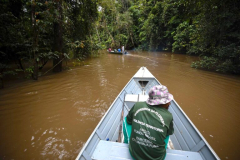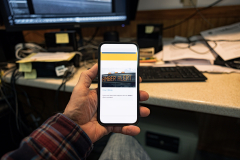- The 2024 extreme and historical drought that hit the Amazon exposed a chronic problem: access to drinking water and sanitation in Indigenous lands, where only a third of households have proper water supply systems.
- In some Amazon rivers in Brazil, cases of diseases related to inadequate basic sanitation, such as malaria and acute diarrhea, have been increasing amid climate change and population growth.
- Indigenous organizations have been demanding the implementation of adapted infrastructures in the villages, such as water tanks, wells, cesspools and septic tanks.
- The Brazilian federal government already has resources and plans to begin addressing these issues.
Mariazinha Baré spent her childhood bathing and playing in the Upper Negro River. Born and raised on the triple border where Brazil meets Colombia and Venezuela, she is now worried about the waters of one of the Amazon’s main rivers.
Illegal mining activities on the border region have been degrading the water in the Negro. Although scientists have shown the river is mostly in good shape, Mariazinha’s concerns echo issues many Indigenous people have been facing in the world’s largest rainforest. Water is getting scarce and worse, especially for drinking.
Mariazinha’s village is located in the Alto Rio Negro Indigenous Territory, whose watercourses shape the livelihoods of 23 ethnic groups, including the Baré people, which in the Nheengatu language means “people of the river.”
The rivers and streams are the basis of everything: transportation to the crops and visiting relatives; fishing, water consumption and personal hygiene. “For us, the river is sacred, because the river is vital,” Mariazinha told Mongabay.
This region is relatively pristine, with almost 99% of the territory covered by protected forests. On the other hand, signs of the climate crisis are already present: The Alto Rio Negro Indigenous Territory has lost a third of its natural water bodies’ surface area between 2015 and 2023, compared with the annual average in the decade between 1985 and 1994, according to the research collective MapBiomas. In addition, illegal mining activities in the border strip have degraded aquatic ecosystems.
“Our biggest concern is with the water. We always use the river water to drink and wash clothes, to make food, to bathe. But after a while, we started collecting rainwater,” said Marizianha, who is a Baré leader and the executive coordinator of the Articulation of Amazonas’ Indigenous Peoples and Organizations.

In 2023 and 2024, the Amazon faced two consecutive extreme droughts, bringing Mariazinha’s fears to a new level. The rivers, including the Negro, reached record lows and communities were forced to rely on provisions of water bottles and tanks as well as contaminated streams to drink water. The problem, however, goes beyond the weather events.
The Amazon Basin is getting drier. In Brazil, the rainforest lost 2 million hectares of natural water bodies from 1985 to 2023, a 16% drop, according to MapBiomas.
This negative trend began in 1995 and poses a severe risk for the Indigenous populations that heavily rely on these resources to live and adapt to a warm and drier climate.
The situation was never as devastating as the 2024 drought, according to Bushe Matis, general coordinator of the Union of Indigenous Peoples of the Javari Valley (UNIVAJA). Javari Valley, Brazil’s second-largest Indigenous land, is home to two river basins that are key to the livelihoods of more than 6,000 inhabitants scattered across 74 villages, in a well-preserved area in Amazonas state.
The igarapés, small streams of clear waters, are their main source for drinking and cooking, while the rivers are used more to bathe and dock boats, for example. But in 2024, Matis saw streams vanishing and becoming undrinkable.
The dry rivers and streams also made the villages inaccessible by fluvial routes, the main mode of transportation in the region. Isolated ethnic groups, such as the Korubo of the Itaguaí River, appeared in search of water and food. Two children — one from the Korubo people, the other from the Kanamari ethnic group — died from diseases associated with poor water quality, according to UNIVAJA.

“The rivers and the igarapés got a stench, a bad smell. At the head of the Ituí River and the Curuçá River, people reached out saying that we had to provide mineral water for them because no one could drink from the river,” Matis told Mongabay.
Logistics also contributed to the calamity. The Secretariat of Indigenous Health (SESAI) had only one small helicopter to operate in the region, which made it difficult to replace medical teams, refill supplies and deliver food as well as to transfer people who needed medical care to the Indigenous health units. The remote communities at the headwaters were heavily impacted — in normal conditions, reaching these villages by river can take up to 20 days from the town of Atalaia do Norte.
“It was really suffocating. We expected that in mid-October the river would be filling up. There was a sign of rain, but the river is still dry. This year was worse, much more than we expected,” Matis said in late 2024.
In October, the federal government released funds for emergency aid to the Amazon’s Indigenous peoples. In January 2025, the rivers and streams there finally began to recover.
Beto Marubo, who represents UNIVAJA in Brasília, Brazil’s federal capital, said he believes the 2024 drought made clear that the country’s governmental institutions, especially the ones related to Indigenous rights, are not ready to deal with the climate emergency.
“We know this is going to be the new normal,” Beto told Mongabay. “So the government needs to think about confronting these climate changes, providing conditions so that regions like the Javari Valley and so many others in the Amazon can be assisted. There is no guarantee that in the next drought we will have food supply for 6,000 people in one of the regions most inaccessible as the Javari Valley.”

A political fight
Along with the drying water bodies comes another important concern for the Javari Valley people: the increase in diseases related to water consumption, such as diarrhea, vomiting and dysentery. “No one is evaluating the water quality. Our only option is to consume what we have,” Matis said.
This reality in the Javari Valley is not limited to the recent droughts. From 2020-23, almost a third of the local population had cases of acute diarrheal disease, according to official data, three times more than in 2018.
“The historic drought of 2024 significantly aggravated the problems of access to quality water and sanitation in the Indige





